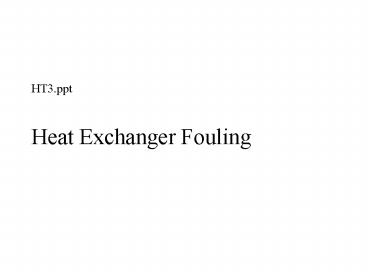HT3'ppt Heat Exchanger Fouling - PowerPoint PPT Presentation
HT3'ppt Heat Exchanger Fouling
Thermal performance analysis (NTUs) for co- & counter-current ... Detergents / caustic soda (hot) Boil with acid (HNO3) High doses of water-softening agents ... – PowerPoint PPT presentation
Title: HT3'ppt Heat Exchanger Fouling
1
HT3.pptHeat Exchanger Fouling
2
Components of Course What Stage are We Up To?
- Types of exchangers, revision of OHTCs, fouling
factors. - Heat exchanger selection.
- Thermal performance analysis (NTUs) for co-
counter-current exchangers. - Multi-pass exchangers (ST).
- Condensation boiling.
- Radiation.
3
Fouling Why Important (Motivation, Context
Relevance)
- Decreases overall heat-transfer coefficient.
- Typical decrease in overall heat-transfer
coefficient in shell-and-tube exchanger is from
1000 W m-2 K-1 to 200 W m-2 K-1 over 1 year in
oil refinery service. - Assessment of fouling use of fouling
predictions common task for graduate engineer.
4
Links to Other Courses
- Process modelling - a spreadsheet analysis may be
helpful curve fitting techniques often necessary.
5
Fouling What Can You Do About It?
- Removal.
- Prevention.
- Design to predictable fouling conditions
(living with it).
6
Removal
- Boil with water for water-soluble salts (e.g.
Ca(OH)2, NaCl, Na2CO3 - Detergents / caustic soda (hot)
- Boil with acid (HNO3)
- High doses of water-softening agents
- Physically / mechanically (drilling,
high-pressure water)
7
Prevention
- Routine chemical dosing (water softening)
- Seed liquid with crystals
- Increase velocity
8
Design to Predictable Fouling Conditions
- Either use
- constant coefficient (often only information
available), classical approach - variable coefficient (with time) where data are
known as function of time from actual operation
(Kern)
9
Curve fitting for coefficients often necessary
10
Conclusions
- Fouling factors come from experience some
previous data available in texts. - To some extent, fouling is preventable.
- Fouling can be removed chemically (in situ) or
mechanically (off-line).
PowerShow.com is a leading presentation sharing website. It has millions of presentations already uploaded and available with 1,000s more being uploaded by its users every day. Whatever your area of interest, here you’ll be able to find and view presentations you’ll love and possibly download. And, best of all, it is completely free and easy to use.
You might even have a presentation you’d like to share with others. If so, just upload it to PowerShow.com. We’ll convert it to an HTML5 slideshow that includes all the media types you’ve already added: audio, video, music, pictures, animations and transition effects. Then you can share it with your target audience as well as PowerShow.com’s millions of monthly visitors. And, again, it’s all free.
About the Developers
PowerShow.com is brought to you by CrystalGraphics, the award-winning developer and market-leading publisher of rich-media enhancement products for presentations. Our product offerings include millions of PowerPoint templates, diagrams, animated 3D characters and more.































